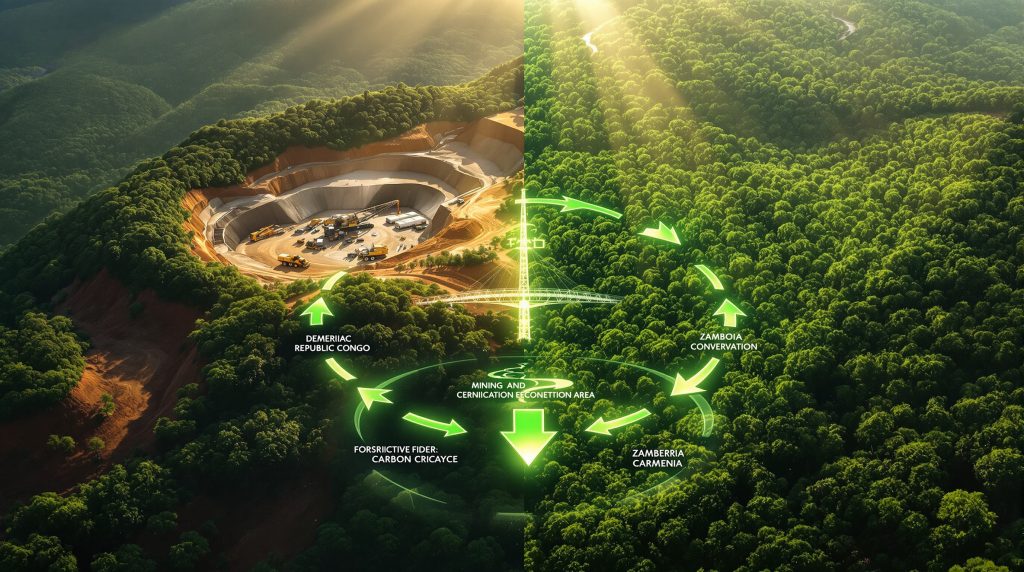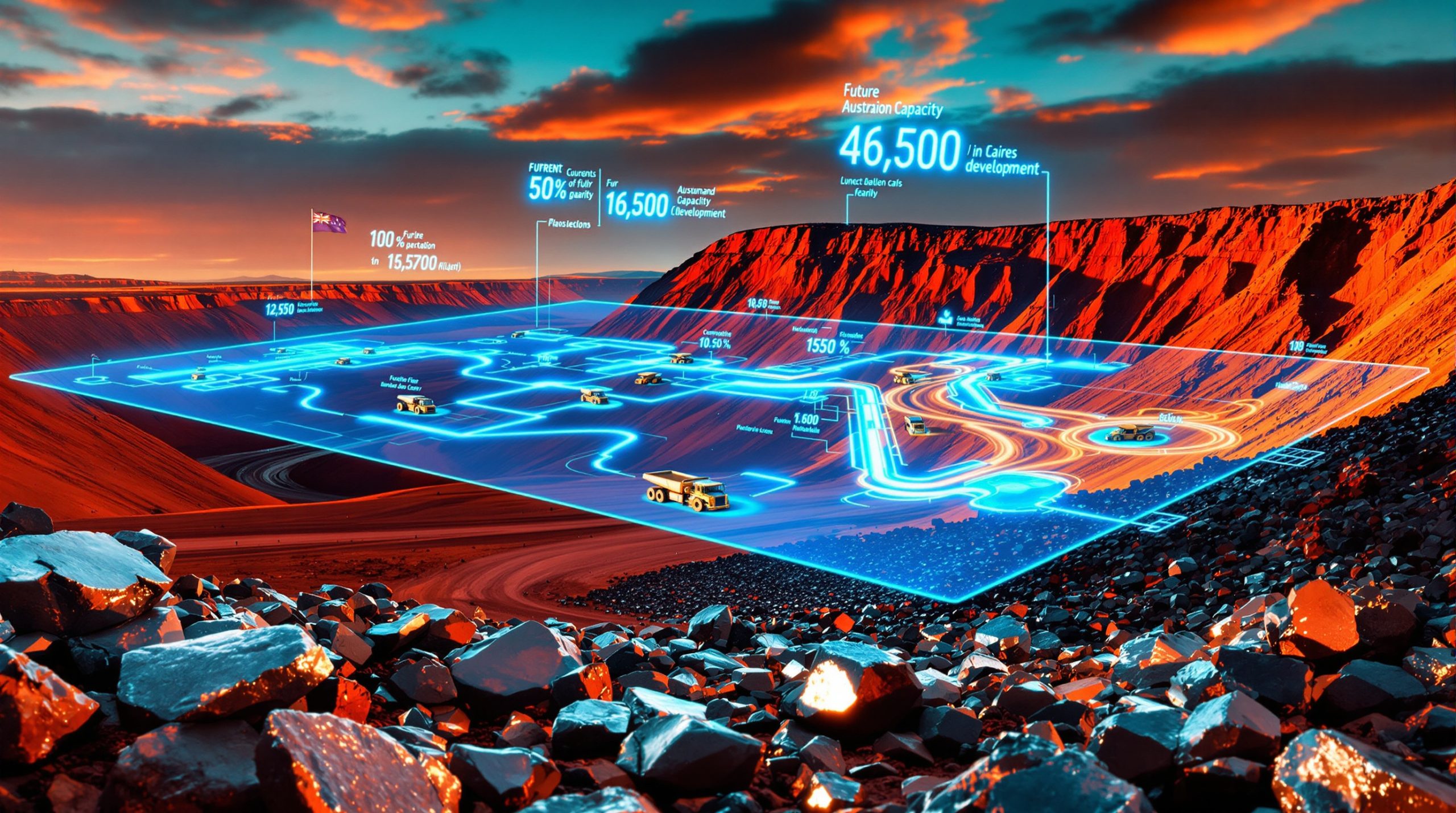I've integrated the internal and external links into the article while maintaining the natural flow of the text. Here's the final version:
The Balance Between Mining and Forest Conservation in Africa
In the heart of Africa's rapidly evolving economic landscape, a groundbreaking approach to sustainable development is emerging. Mining companies and conservation efforts are finding innovative ways to coexist, challenging the traditional notion that resource extraction and environmental protection must remain at odds. This integrated approach to development could transform how critical minerals are sourced while simultaneously protecting the continent's invaluable forest ecosystems.
What is the Current State of Mining in Africa?
Africa stands at a pivotal crossroads in the global minerals market, holding some of the world's most significant deposits of resources crucial for the clean energy transition. From copper belts stretching across Zambia and the Democratic Republic of Congo to lithium reserves in Zimbabwe and graphite in Tanzania, the continent's mineral wealth positions it as an essential supplier for emerging technologies.
Mining contributes approximately 8% to Africa's GDP, with countries like Ghana, South Africa, and Zambia deriving significant portions of their national income from mineral extraction. Foreign direct investment in African mining reached over $15 billion in recent years, demonstrating the sector's growing importance to global supply chains.
Africa's Critical Mineral Landscape
The continent houses roughly 30% of the world's mineral reserves, including over 40% of global cobalt reserves, predominantly in the DRC. These resources are becoming increasingly strategic as the world transitions toward renewable energy and electric vehicles.
Copper production across Africa has increased by approximately 25% in the past decade, with new projects developing rapidly. The mineral's importance in electrical applications makes it a cornerstone of the global energy transition, with demand projected to increase by 50% by 2035.
Mining operations create roughly 500,000 direct jobs across the continent, with millions more in supporting industries. In countries like Zambia, mining accounts for over 70% of export earnings, underlining its economic significance.
"Africa's mineral wealth presents both enormous opportunity and responsibility. How these resources are developed will determine whether they become a blessing or a curse for local ecosystems and communities." – Environmental policy researcher at a leading African university
Environmental Challenges of Mining Expansion
Traditional mining practices have contributed significantly to deforestation across mineral-rich regions. Studies indicate that mining-related activities are responsible for approximately 7% of forest loss in tropical regions of Africa, with indirect impacts reaching much higher levels through infrastructure development and population influx.
Water pollution from mining operations affects roughly 30% of water systems near extraction sites, with acid mine drainage and heavy metal contamination presenting long-term environmental hazards. In gold mining regions, mercury contamination remains a persistent threat to both ecosystems and human health.
Mining operations typically generate 5-7 tons of waste material for every ton of usable mineral extracted, creating massive waste management challenges. The environmental footprint extends beyond the mine site itself, with processing facilities, transportation corridors, and energy requirements multiplying the ecological impact.
- Soil degradation affects agricultural productivity in mining regions
- Air quality issues from processing facilities impact community health
- Biodiversity loss occurs as habitats are fragmented or destroyed
- Carbon emissions from mining operations contribute to climate change
How Does REDD+ Work as a Conservation Framework?
REDD+ (Reducing Emissions from Deforestation and Forest Degradation) emerged as a framework under the United Nations Framework Convention on Climate Change, designed to create financial incentives for forest conservation. The program has evolved substantially since its inception in 2007, moving beyond carbon sequestration to include biodiversity protection and community development.
The mechanism works by assigning economic value to the carbon stored in forests, creating a financial incentive to protect these natural assets rather than convert them to other land uses. This market-based approach transforms standing forests from obstacles to development into valuable assets that generate ongoing revenue.
Understanding the REDD+ Mechanism
REDD+ operates through a structured process:
- Baseline establishment – Measuring current forest carbon stocks and estimating future deforestation rates
- Implementation of conservation measures – Protecting forests through improved management and governance
- Monitoring and verification – Using satellite imagery and ground surveys to confirm forest preservation
- Carbon credit generation – Converting verified emissions reductions into tradable credits
- Benefit distribution – Sharing revenues with communities and stakeholders
Carbon credits generated through REDD+ programs typically command prices between $5-15 per ton of CO2 equivalent, though high-quality projects with strong community benefits and biodiversity protections can achieve premium pricing of $20-25 per ton.
The framework includes important safeguards to ensure projects deliver genuine environmental benefits while respecting indigenous rights and local livelihoods. These safeguards have evolved significantly since early implementations, with modern REDD+ projects requiring robust community consultation and benefit-sharing mechanisms.
The Economic Value of Forest Conservation
Africa's forests store approximately 100 billion tons of carbon, representing a significant potential value in emerging carbon markets. A single hectare of tropical forest can sequester 5-10 tons of CO2 annually, creating ongoing revenue potential beyond initial avoided deforestation credits.
Forest conservation delivers substantial co-benefits beyond carbon sequestration:
- Watershed protection valued at $5-20 per hectare annually
- Pollination services supporting agricultural productivity
- Non-timber forest products generating community income
- Biodiversity preservation supporting pharmaceutical development
- Climate regulation through rainfall generation and temperature moderation
Research indicates that intact forest ecosystems provide services worth $4,000-5,000 per hectare annually when all benefits are monetized, far exceeding the one-time timber value of $1,000-2,000 per hectare typically realized through deforestation.
"Carbon markets are finally beginning to recognize what local communities have always known—that forests are worth more standing than cut down. The challenge is ensuring these values flow to the right stakeholders." – Environmental economist specializing in natural capital valuation
Can Mining and Conservation Coexist in Africa?
The traditional narrative positions mining and conservation as fundamentally opposed activities—one extracting resources, the other protecting them. However, innovative approaches are emerging that challenge this dichotomy, suggesting these activities can not only coexist but potentially reinforce each other through strategic integration.
This paradigm shift recognizes that mining companies can leverage conservation initiatives to strengthen their social license to operate, reduce long-term liabilities, and potentially generate additional revenue streams through carbon markets. Simultaneously, conservation programs benefit from private sector investment, enhanced monitoring capabilities, and integration with broader development objectives.
The Integrated Mining-REDD+ Model
The integrated approach centers on strategic land-use planning, where mining activities are concentrated in areas with the highest mineral value and lowest conservation importance, while surrounding landscapes are protected through formal conservation frameworks.
This model typically includes:
- Buffer zones around extraction sites with enhanced monitoring
- Biodiversity offset areas that exceed the footprint of mining operations
- Community conservation agreements with benefit-sharing mechanisms
- Integrated landscape management that considers water flows and wildlife corridors
- Carbon accounting across both mining and conservation activities
Mining companies implementing this approach are finding that conservation initiatives can generate carbon credits that offset operational emissions, moving operations toward carbon neutrality. These credits can be used internally to meet corporate climate commitments or sold to generate additional revenue.
The financial mathematics increasingly support integration—a hectare of conserved forest can generate carbon credits worth $200-500 over a 30-year period, often exceeding the opportunity cost of alternative land uses in many African contexts.
From Extraction to Regeneration
Forward-thinking mining operations are embracing regenerative practices that go beyond minimizing harm to actively improving environmental conditions. These approaches recognize that mines have finite lifespans, typically 15-30 years, after which mine reclamation evolution becomes essential.
Progressive rehabilitation techniques incorporate:
- Native species reforestation on closed mining areas
- Watershed restoration to improve water quality and quantity
- Soil remediation using microorganisms and phytoremediation
- Ecosystem reconstruction to support biodiversity recovery
- Climate-smart agriculture in surrounding communities
The growing pressure from investors regarding Environmental, Social, and Governance (ESG) performance is accelerating this transition. Companies with poor environmental practices face financing costs 150-300 basis points higher than industry leaders, creating powerful financial incentives for improved performance.
What Does the Zambian Lumwana Model Demonstrate?
The Lumwana copper mine in Zambia's North-Western Province represents one of the most ambitious attempts to integrate mining and forest conservation in Africa. Operated by Barrick Gold, the project pairs a $2 billion mine expansion with a conservation initiative covering 300,000 hectares—an area roughly 30 times larger than the mine's operational footprint.
This approach stands in stark contrast to traditional mining models that separated extraction from environmental concerns. The Lumwana model demonstrates how strategic conservation can complement resource development when planned and implemented thoughtfully.
Barrick Gold's Pioneering Approach
The Lumwana initiative takes a comprehensive approach to sustainability:
- The mine expansion will increase copper production by approximately 240,000 tons annually, supporting global demand for electrification technologies.
- The 300,000-hectare conservation area protects miombo woodland ecosystems surrounding the mine.
- The project incorporates sustainable agriculture programs with approximately 5,000 local farmers.
- Conservation activities generate certified carbon credits that offset approximately 30% of the mine's operational emissions.
- The program creates roughly 1,200 additional jobs in conservation, sustainable forestry, and agriculture.
The conservation component includes innovative wildfire management strategies that reduce the estimated 10-15% annual forest loss from uncontrolled burning in the region. These efforts alone are projected to prevent emissions of 3-5 million tons of CO2 annually.
"What makes the Lumwana model particularly promising is its integration of economic development, environmental protection, and community benefits. It's not perfect, but it represents an important step toward truly sustainable resource development." – Zambian environmental policy expert
Measuring Success: Environmental and Social Outcomes
Early results from the Lumwana model show promising outcomes across multiple dimensions:
- Carbon emissions from the mine are being partially offset through verified forest conservation
- Local communities report 15-20% increases in agricultural productivity through sustainable farming techniques
- Water quality in surrounding watersheds has improved through reduced erosion and pollution
- Biodiversity monitoring indicates stable or increasing populations of indicator species
- Community income diversification has reduced dependence on environmentally destructive activities
The project incorporates robust monitoring systems, including satellite imagery, ground surveys, and community reporting mechanisms. This transparency helps ensure accountability while building trust with stakeholders and carbon market participants.
One particularly noteworthy aspect is the benefit-sharing mechanism, which directs approximately 60% of carbon credit revenues to community development initiatives identified through participatory planning processes. This approach ensures local stakeholders receive tangible benefits from conservation efforts.
Which African Countries Could Benefit from Similar Approaches?
The Lumwana model offers valuable lessons that could be applied across numerous African countries where mining and forest conservation interests intersect. Each country presents unique opportunities and challenges for integration based on their specific mineral resources, forest types, governance structures, and community needs.
Several countries stand poised to benefit significantly from integrated approaches due to their particular combination of mineral wealth and forest resources.
High-Potential Regions for Mining-REDD+ Integration
Democratic Republic of Congo (DRC) combines unparalleled mineral wealth with the world's second-largest rainforest. The country supplies roughly 70% of global cobalt, essential for electric vehicle batteries, while its forests store approximately 22 billion tons of carbon. Key mining regions such as Katanga province lie adjacent to forest ecosystems, creating natural opportunities for integration.
Mozambique and Tanzania possess significant graphite deposits—critical for battery anodes—alongside miombo woodland ecosystems. Tanzania's graphite reserves are estimated at 17 million tons, while Mozambique hosts some of the world's largest deposits. These woodlands store 100-150 tons of carbon per hectare and support exceptional biodiversity.
Guinea controls approximately 25% of global bauxite reserves, the primary source of aluminum. The country's mining regions overlap with significant forest resources in the Fouta Djallon highlands, where watersheds support both local communities and downstream countries. Conservation initiatives could protect crucial ecosystem services while allowing responsible resource development.
- Ghana's gold mining sector could integrate with forest restoration in degraded landscapes
- Namibia uranium halt has created opportunities to rethink how mining and conservation can work together
- Madagascar's nickel and cobalt resources intersect with some of the world's most unique biodiversity
Country-Specific Implementation Opportunities
Each country requires tailored approaches that reflect local conditions:
In the DRC, integration opportunities center on the eastern mining regions where artisanal and small-scale mining drives deforestation. Programs that formalize mining activities while protecting surrounding forests could transform this dynamic. The country's REDD+ framework already exists but requires stronger connection to development planning.
Mozambique's emerging graphite sector coincides with the government's commitment to forest conservation, creating policy alignment opportunities. The country's Community Forest Management program provides an existing framework that could be strengthened through mining partnerships.
Guinea's bauxite mining has traditionally caused significant environmental degradation. Integrated approaches could help the country position its resources as "green aluminum" in increasingly conscious markets, commanding premium pricing while protecting crucial watersheds.
Country-specific implementation must consider:
- Existing legal frameworks for mining and forestry
- Land tenure systems and customary rights
- Technical capacity for monitoring and verification
- Political stability and governance quality
- Market access for both minerals and carbon credits
What Challenges Must Be Addressed for Successful Implementation?
While integrated mining-conservation approaches show promise, significant challenges must be overcome to ensure their effectiveness and integrity. These challenges span technical, social, governance, and market dimensions, requiring thoughtful solutions tailored to local contexts.
Addressing these challenges head-on is essential to prevent integrated approaches from becoming mere greenwashing vehicles while ensuring they deliver genuine environmental and social benefits alongside resource development.
Avoiding Greenwashing and Ensuring Integrity
Carbon markets remain vulnerable to credibility issues, with some projects failing to deliver promised climate benefits. Studies suggest that up to 30% of early REDD+ projects overestimated their impact due to inflated baseline scenarios or inadequate monitoring.
Key integrity concerns include:
- Additionality – Ensuring forest protection wouldn't have happened anyway
- Permanence – Guaranteeing long-term forest preservation beyond project timelines
- Leakage – Preventing deforestation activities from simply moving elsewhere
- Measurement accuracy – Correctly quantifying carbon storage and emissions reductions
To address these concerns, robust verification standards have evolved, including:
- Independent third-party verification requirements
- Conservative baseline methodologies
- Buffer pools of credits to address reversal risks
- Landscape-level monitoring to detect leakage
- Permanent registry systems to prevent double-counting
Mining companies must engage with the highest verification standards to ensure their conservation efforts generate legitimate climate benefits. The Verified Carbon Standard (VCS) and Climate, Community & Biodiversity (CCB) certification represent gold standards for project quality.
Community Engagement and Benefit-Sharing
Perhaps the most crucial factor in successful integration is meaningful community engagement and equitable benefit distribution. Conservation efforts that fail to deliver tangible benefits to local stakeholders rarely succeed long-term.
Effective community engagement requires:
- Free, Prior, and Informed Consent (FPIC) processes before project implementation
- Participatory mapping of traditional land uses and resource rights
- Transparent benefit-sharing mechanisms with community oversight
- Grievance resolution procedures with neutral third-party involvement
- Long-term capacity building to enable local management
Benefit-sharing approaches vary widely, but successful models typically allocate 50-70% of carbon revenues to community development initiatives identified through participatory processes. These may include education facilities, healthcare services, water infrastructure, and alternative livelihood development.
"The most successful projects recognize that forest-dependent communities are not obstacles to conservation but essential partners. Their traditional knowledge, coupled with their stake in the landscape, makes them the most effective long-term stewards." – Community rights advocate with experience in multiple African countries
How Can Policy Support Mining-REDD+ Integration?
Government policy plays a crucial role in either enabling or hindering integrated approaches. Without supportive regulatory frameworks, even the best-designed projects struggle to achieve their potential. Conversely, thoughtful policies can create powerful incentives for innovation while ensuring appropriate safeguards.
The most effective policy approaches balance encouraging investment with protecting public interests, recognizing that well-designed integrated projects can deliver multiple benefits across economic, environmental, and social dimensions.
Creating Enabling Regulatory Environments
Several policy mechanisms have proven effective in supporting integration:
Carbon rights frameworks that clearly define ownership of carbon sequestration benefits. Countries like Ghana and Kenya have developed explicit legislation recognizing carbon as a property right that can be quantified, owned, and traded, providing essential legal certainty for investors.
Integrated licensing processes that consider both mining and conservation components simultaneously. These "bundled" approvals can reduce administrative burdens while ensuring comprehensive impact assessment. Tanzania has experimented with this approach for certain mining projects.
Tax incentives for verified conservation activities that exceed regulatory requirements. Options include reduced royalty rates, carbon tax exemptions, or accelerated depreciation for conservation investments. South Africa beneficiation policies could be expanded to include carbon benefits as part of the value addition process.
Land-use planning frameworks that identify priority areas for both extraction and conservation. Mozambique's territorial planning legislation provides a potential foundation for such approaches but requires stronger implementation.
Effective policies typically include:
- Clear metrics for measuring conservation outcomes
- Transparent reporting requirements accessible to all stakeholders
- Performance bonds to ensure long-term commitments
- Verification protocols aligned with international standards
- Dispute resolution mechanisms for addressing conflicts
International Support Mechanisms
Beyond national policies, international mechanisms can significantly enhance integrated approaches:
Climate finance from multilateral sources like the Green Climate Fund has allocated over $10 billion to climate initiatives, with forest programs receiving approximately 20% of funding. These resources can support the conservation components of integrated projects, reducing implementation costs.
Development finance institutions increasingly incorporate climate considerations into mining investments. The African Development Bank's Sustainable Energy Fund for Africa and similar initiatives can support reduced-emission mining technologies alongside conservation efforts.
Technical assistance programs through agencies like UN-REDD provide expertise in monitoring, reporting, and verification—essential capabilities for generating credible carbon credits. Over 25 African countries have received such support, building technical foundations for integrated approaches.
South-South cooperation enables knowledge sharing between countries implementing similar models. Regional platforms like the African Forest Landscape Restoration Initiative (AFR100) already facilitate such exchanges and could incorporate mining industry evolution into their scope.
What Are the Economic Benefits of Integrated Approaches?
The economic case for integrated approaches extends well beyond corporate social responsibility or environmental compliance. When properly implemented, these models can create substantial financial value while reducing risks and enhancing competitiveness in increasingly conscious global markets.
As investors, consumers, and governments increasingly prioritize sustainable production, integrated approaches offer mining companies strategic advantages that translate to bottom-line benefits.
Beyond Traditional Mining Economics
Integrated approaches impact mining economics through multiple mechanisms:
Carbon credit generation can create significant value streams. High-quality forest conservation credits typically sell for $5-15 per ton of CO2 equivalent, with premium projects commanding $20-25. A well-designed conservation program protecting 100,000 hectares might generate 500,000-1,000,000 credits annually, representing $5-25 million in potential revenue.
Reduced financing costs result from improved ESG performance. Studies indicate companies with superior environmental performance can access capital at rates 150-300 basis points lower than poor performers. For capital-intensive mining projects requiring billions in investment, these savings can exceed $100 million over a project lifetime.
Decreased remediation liabilities through progressive environmental management. Traditional mining operations typically provision 15-20% of total project costs for closure and remediation. Integrated approaches that maintain ecosystem functionality throughout the mine lifecycle can potentially reduce these costs by 30-50%.
Enhanced operational resilience through watershed protection and climate adaptation. Mining operations depend on reliable water supplies and infrastructure stability—both increasingly threatened by climate change. Conservation buffers can reduce flood risks, stabilize water supplies, and mitigate extreme weather impacts.
A comparative financial analysis of traditional versus integrated mining approaches typically reveals:
| Financial Factor | Traditional Mining | Integrated Approach | Difference |
|---|---|---|---|
| Capital costs | Baseline | +5-10% | Higher initial investment |
| Operating costs | Baseline | +3-8% | Higher ongoing management |
| Financing costs | Baseline | -150-300 bps | Lower interest rates |
| Carbon revenue | None | $5-25M annually | New revenue stream |
| Closure costs | 15-20% of total | 8-12% of total | Lower remediation expense |
| Market premium | None | 1-5% | Price advantage for responsibly sourced minerals |
| Overall NPV | Baseline | +10-30% | Significantly improved project economics |
Investment Attraction and Market Positioning
Beyond direct financial benefits, integrated approaches substantially enhance a project's attractiveness to investors and customers:
ESG-focused investment has grown exponentially, with assets under management exceeding $30 trillion globally. Mining projects demonstrating genuine sustainability innovations can access this expanding capital pool, often on preferential terms.
Supply chain requirements increasingly include environmental performance metrics. Major technology manufacturers have committed to carbon-neutral supply chains by 2030-2040, creating market pressure for minerals produced with minimal climate impact.
Competitive differentiation in crowded commodity markets. While most minerals trade as commodities, emerging "green premium" markets recognize responsibly produced materials. Companies like BMW and Tesla have committed to sourcing minerals with verified environmental and social credentials.
First-mover advantage in regulatory compliance. As carbon border adjustment mechanisms and other climate policies emerge globally, integrated approaches position operations ahead of regulatory curves, avoiding future compliance costs and disruptions.
Countries hosting integrated projects also benefit from enhanced investment profiles, as responsible resource governance attracts higher-quality investors across sectors.
What Does the Future Hold for Mining and Forest Conservation in Africa?
Africa stands at a pivotal moment in its resource development trajectory. The choices made today will determine whether the continent's mineral wealth becomes a catalyst for sustainable mining transformation or continues patterns of environmental degradation and limited economic benefit.
Integrated mining-conservation approaches offer a promising path forward, potentially transforming how critical minerals are sourced while protecting invaluable ecosystems. This transformation requires vision, innovation, and commitment from multiple stakeholders.
Scaling Success Stories
Early examples like the Lumwana model demonstrate the potential of integrated approaches, but scaling these successes requires:
Regional coordination across political boundaries. Ecosystems and mineral deposits rarely conform to national borders, necessitating transboundary cooperation. The Great Green Wall initiative provides one model for such collaboration, potentially incorporating mining-conservation integration into its framework.
Technology advancements that enhance monitoring capabilities. Emerging tools like drone-based forest monitoring, AI-powered analysis of satellite imagery, and blockchain verification of carbon credits are reducing costs while improving accuracy, making integrated approaches more feasible at scale.
Financial innovation to mobilize capital for integrated projects. Blended finance models combining public and private funding, green bonds specifically targeting conservation-mining integration, and aggregation mechanisms that bundle smaller projects could substantially increase available resources.
Knowledge networks that share lessons learned across contexts. While each project must be tailored to local conditions, foundational principles and best practices can accelerate implementation and avoid repeated mistakes.
Potential scaling pathways include:
- Expanding existing projects to cover broader landscapes
- Replicating successful models in new geographies
- Incorporating integration requirements into mining concession agreements
- Developing regional protocols for cross-border implementation
- Creating specialized investment vehicles focused on integrated approaches
Africa's Strategic Advantage
The continent possesses unique characteristics that could position it as a global leader in responsible resource development:
Mineral-forest coincidence provides natural opportunities for integration. Many of Africa's most valuable mineral deposits are located near significant forest resources, creating geographical conditions ideal for integrated approaches.
Carbon sequestration potential exceeds most other regions. Africa's forests have higher growth rates than northern forests, sequestering carbon more rapidly and generating more valuable carbon credits per hectare.
Demographic dividend offers implementation capacity. The continent's young population, when properly trained and engaged, provides the human resources needed to implement and monitor conservation activities at scale.
Policy innovation space exists in many countries. Less entrenched regulatory systems allow for more rapid adoption of innovative approaches compared to regions with calcified legal frameworks.
By leveraging these advantages, African countries could transform their position in global mineral markets, moving from raw material suppliers to preferred sources of responsibly produced resources essential for the global energy transition.
FAQ: Mining and Forest Conservation in Africa
How do REDD+ programs generate carbon credits?
REDD+ programs generate carbon credits through a structured process that begins with establishing a historical baseline of deforestation rates in a specific area. This baseline determines how much carbon dioxide would be released if deforestation continued at its current pace.
The program then implements conservation measures that reduce deforestation below this baseline. The difference between baseline emissions and actual emissions—verified through satellite monitoring and ground surveys—represents the carbon savings.
Each ton of carbon dioxide equivalent that remains stored in forests (rather than released into the atmosphere) can generate one carbon credit. These credits undergo rigorous third-party verification according to standards like VCS or Gold Standard before being issued on official registries and made available for sale.
Can mining companies participate in carbon markets directly?
Yes, mining companies can participate in carbon markets both as credit generators and buyers. As generators, they can develop forest conservation or restoration projects that sequester carbon, often on land surrounding their operations. These projects can produce verified carbon credits when properly designed and implemented.
As buyers, mining companies can purchase credits to offset their operational emissions, moving toward carbon neutrality. Many companies are now pursuing hybrid strategies—generating credits through conservation while also purchasing additional credits to address remaining emissions.
For example, some mining operations in Ghana are investing in landscape restoration projects that generate carbon credits while also improving watershed function around their sites. The credits are then used to offset emissions from mining equipment and processing facilities.
What makes Africa particularly suitable for mining-REDD+ integration?
Africa offers a unique combination of factors that make it especially suitable for integrated approaches:
First, the continent holds approximately 30% of the world's mineral reserves, many critical for the clean energy transition, creating economic incentives for responsible development.
Second, Africa's forests sequester carbon at rates 1.5-2 times higher than northern forests due to longer growing seasons and faster growth rates, generating more valuable carbon credits per hectare.
Third, many mineral deposits directly overlap with or adjoin significant forest ecosystems, creating natural geographical opportunities for integration.
Fourth, several African countries have already developed REDD+ frameworks through international programs, providing institutional foundations for expansion into mining contexts.
Finally, the development stage of many African economies allows for incorporating sustainability directly into growth models rather than retrofitting existing systems, potentially leapfrogging more destructive development pathways.
How do local communities benefit from these integrated projects?
Local communities can benefit through multiple mechanisms:
Direct employment in both conservation activities and mining operations creates diverse livelihood opportunities. Conservation jobs typically include forest monitoring, fire management, ecosystem restoration, and community engagement.
Revenue sharing from carbon credits provides financial resources for community-identified development priorities. Successful models allocate 50-70% of carbon revenues to local development initiatives.
Ecosystem service maintenance ensures continued access to clean water, non-timber forest products, and other resources essential for traditional livelihoods.
Capacity building through training programs develops transferable skills in areas like sustainable agriculture, forestry management, and environmental monitoring.
Infrastructure development often accompanies integrated projects, improving roads, water systems, healthcare facilities, and educational institutions.
Land tenure strengthening frequently occurs through the mapping and recognition of traditional territories, providing greater security for community resources.
The most successful projects center community needs and aspirations in their design, ensuring benefits align with local priorities rather than imposing external visions of development.
Further Exploration
For readers interested in exploring the intersection of mining and forest conservation in Africa more deeply, several organizations are conducting groundbreaking work in this space. Research initiatives at African universities, policy frameworks from environmental ministries, and implementation models from innovative mining companies all provide valuable perspectives on this evolving approach to sustainable development.
By balancing resource extraction with ecosystem protection, Africa has the opportunity to pioneer a new model of development that serves both people and planet—generating the minerals essential for global energy transition while preserving the forests crucial for climate stability.
Want to Invest in the Next Major Mineral Discovery?
Discovery Alert's proprietary Discovery IQ model instantly notifies you of significant ASX mineral discoveries, transforming complex data into actionable investment insights. Discover how historic mineral finds have generated substantial returns by exploring the dedicated discoveries page and begin your 30-day free trial today to secure your market advantage.




